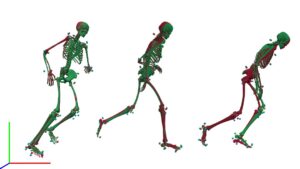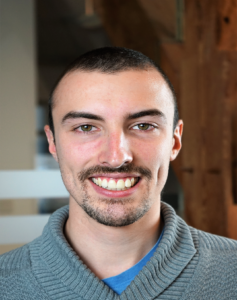Subproject C01
Subproject C01
Machine Learning for Personalization of Musculoskeletal Models, Movement Analysis, and Movement Predictions
In this subproject, we first identify musculoskeletal model parameters important for personalisation using a sensitivity analysis. Then, we investigate how we can personalize movement simulations based on body hulls or movement data.
From recorded body hull, we estimate the location of different tissue types using existing models and estimate inertial parameters for each body segment. When body hulls are not available, we aim to find musculoskeletal model parameters that best explain measured movement data. The resulting musculoskeletal models are then validated with medical imaging.

To predict movements, we optimize a person’s movement through optimal control, using different criteria like cost of transport, muscular effort, foot-ground impact, head stabilization, and others. To best recreate specific motions, inverse optimal control (IOC) is used to find specific weights for each criterion. To explore human walking criteria like the influence of environmental and personal conditions we are developing a fast IOC pipeline for real-world data and predicting new gaits from weighted criteria.
Contacts
Prof. Dr. Anne Koelewijn
Principal Investigator
Theo Balougias
Doctoral Candidate
Markus Gambietz, M. Sc.
Doctoral Candidate
Additional Information
- Balbach S., Kolpak J., Dorn C., Brückner S., Schlechtweg N., Gambietz M., Koelewijn A., Vossiek M., Hagelauer A.:
A Miniaturized Flexible Surface Electromyography Sensor With an Integrated Localization Concept.
IEEE Microwave Magazine 26 (2025), S. 47-59. ISSN: 1527-3342. DOI: 10.1109/MMM.2024.3494717. - Dorschky E., Nitschke M., Mayer M., Weygers I., Gaßner H., Seel T., Eskofier B., Koelewijn A.:
Comparing sparse inertial sensor setups for sagittal-plane walking and running reconstructions.
Frontiers in Bioengineering and Biotechnology 13 (2025), Art.Nr.: 1507162. ISSN: 2296-4185. DOI: 10.3389/fbioe.2025.1507162. - Fleischmann S., Shanbhag J., Miehling J., Wartzack S., Ong C., Eskofier B., Koelewijn A.:
A model of the cerebellum generates gait adaptations in a reflex-based neuromusculoskeletal model during split-belt walking.
Journal of NeuroEngineering and Rehabilitation 22 (2025), Art.Nr.: 256. ISSN: 1743-0003. DOI: 10.1186/s12984-025-01818-2. - Gambietz M., Qistina Azam P., Wechsler I., Menzel T., Botsch M., Miehling J.:
Smartphone-based musculoskeletal model personalization – A proof of concept MRI validation study.
The XXX Congress of the International Society of Biomechanics (Stockholm, 27 Juli 2025 – 31 Juli 2025). - Shanbhag J., Fleischmann S., Wechsler I., Gaßner H., Winkler J., Eskofier B., Koelewijn A., Wartzack S., Miehling J.:
Does reduced reactivity explain altered postural control in Parkinson’s disease? A predictive simulation study.
IEEE Open Journal of Engineering in Medicine and Biology (2025). ISSN: 2644-1276. DOI: 10.1109/OJEMB.2025.3590580. - Shanbhag J., Fleischmann S., Wechsler I., Winkler J., Gaßner H., Eskofier BM., Koelewijn A., Wartzack S., Miehling J.:
Increased Signal Noise Results in Altered Postural Control Beaviour Associated with Parkinson’s Disease
The XXX Congress of the International Society of Biomechanics (Stockholm, 27 Juli 2025 – 31 Juli 2025) - Shanbhag J., Wechsler I., Wirsching S., Fleischmann S., Winkler J., Gaßner H., Eskofier BM., Koelewijn A., Wartzack S., Miehling J.:
The Challenge of Balancing Predictive and Personalized Simulations of Upright Standing.
The XXX Congress of the International Society of Biomechanics (Stockholm, 27 Juli 2025 – 31 Juli 2025) - Wechsler I., Shanbhag J., Wartzack S., Koelewijn A., Miehling J.:
Controller-based Tracking of Multimodal Motion Data.
The XXX Congress of the International Society of Biomechanics (Stockholm, 27 Juli 2025 – 31 Juli 2025). - Wechsler I., Shanbhag J., Wartzack S., Koelewijn A., Miehling J.:
IMU-based joint axis identification method for arbitrary joints in OpenSim – a simulation study.
BMC Biomedical Engineering 7 (2025), Art.Nr.: 16. DOI: 10.1186/s42490-025-00102-7. - , , , , , , , , , :
Exploring Dataset Bias and Scaling Techniques in Multi-Source Gait Biomechanics: An Explainable Machine Learning Approach.
ACM Transactions on Intelligent Systems and Technology 20 (2024), Art.Nr.: 20. ISSN: 2157-6904. DOI: 10.1145/3702646. - , , , , , , , , , , , , , , :
Classification of rheumatoid arthritis from hand motion capture data using machine learning.
13. Kongress der Deutschen Gesellschaft für Biomechanik (DGfB) (Heidelberg, 24 April 2024 – 26 April 2024). - Gambietz M., Dröge A., Schüßler C., Stahlke M., Wirth V., Miehling J., Koelewijn A.:
Unobtrusive Gait Reconstructions using Radar-based Optimal Control Simulations.
Asilomar Conference on Signals, Systems, and Computers (2024). - Krauß D., Engel L., Ott T., Bräunig J., Richer R., Gambietz M., Albrecht N., Hille EM., Ullmann I., Braun M., Dabrock P., Kölpin A., Koelewijn A., Eskofier B., Vossiek M.:
A Review and Tutorial on Machine Learning- Enabled Radar-Based Biomedical Monitoring.
IEEE Open Journal of Engineering in Medicine and Biology (2024), S. 1-22. ISSN: 2644-1276. DOI: 10.1109/OJEMB.2024.3397208. - Miehling J., Choisne J., Koelewijn A.:
Editorial: Human digital twins for medical and product engineering.
Frontiers in Bioengineering and Biotechnology 12 (2024). ISSN: 2296-4185. DOI: 10.3389/fbioe.2024.1489975. - Nitschke M., Dorschky E., Leyendecker S., Eskofier B., Koelewijn A.:
Estimating 3D kinematics and kinetics from virtual inertial sensor data through musculoskeletal movement simulations.
Frontiers in Bioengineering and Biotechnology 12 (2024). ISSN: 2296-4185. DOI: 10.3389/fbioe.2024.1285845. - Schlechtweg N., Brückner S., Gambietz M., Koelewijn A., Vossiek M.:
Time-Synchronized Joint Communication and Precise Wireless Localization of Multiple On-Body Sensor Nodes for Human Gait and Movement Measurement.
Asilomar Conference on Signals, Systems, and Computers (2024). - Shanbhag J., Fleischmann S., Wechsler I., Gaßner H., Winkler J., Eskofier B., Koelewijn A., Wartzack S., Miehling J.:
A sensorimotor enhanced neuromusculoskeletal model for simulating postural control of upright standing.
Frontiers in Neuroscience 18 (2024). ISSN: 1662-4548. DOI: 10.3389/fnins.2024.1393749. - Wechsler I., Wartzack S., Koelewijn A., Miehling J.:
IMU-based direct analytical joint center identification method for OpenSim – A proof of concept.
29th Congress of the European Society of Biomechanics (Edinburgh, Scotland, 2024). - Wechsler I., Wolf A., Shanbhag J., Leyendecker S., Eskofier B., Koelewijn A., Wartzack S., Miehling J.:
Bridging the sim2real gap. Investigating deviations between experimental motion measurements and musculoskeletal simulation results—a systematic review.
Frontiers in Bioengineering and Biotechnology 12 (2024). ISSN: 2296-4185. DOI: 10.3389/fbioe.2024.1386874. - Weiß A., Chen A., Janischowky DB., Shih I., Phillips G., Selinger JC., Koelewijn A.:
Pairing Predictive Simulations and Human Experiments in Ankle Exoskeleton Walking.
2024 10th IEEE RAS/EMBS International Conference for Biomedical Robotics and Biomechatronics (BioRob) (, 1 September 2024 – 4 September 2024). DOI: 10.1109/BioRob60516.2024.10719905. - Dorschky E., Camomilla V., Davis J., Federolf P., Reenalda J., Koelewijn A.:
Perspective on “in the wild” movement analysis using machine learning.
Human Movement Science (2023). - Fleischmann S., Shanbhag J., Miehling J., Wartzack S., Leyendecker S., Koelewijn A., Eskofier B.:
Time vs. Space: Comparing gait cycle normalization methods and their effect on foot placement control.
28th Congress of the European Society of Biomechanics (Maastricht, 9 Juli 2023 – 12 Juli 2023). - Gambietz M., Nitschke M., Miehling J., Koelewijn A.:
Contributing components of metabolic energy models to metabolic cost estimations in gait.
IEEE Transactions on Biomedical Engineering (2023). - Nitschke M., Marzilger R., Leyendecker S., Eskofier B., Koelewijn A.:
Change the direction: 3D optimal control simulation by directly tracking marker and ground reaction force data.
PeerJ (2023). - Shanbhag J., Fleischmann S., Eskofier B., Koelewijn A., Wartzack S., Miehling J.:
Towards postural control simulation using a sensorimotor enhanced musculoskeletal human model.
ISPGR World Congress 2023 (Brisbane, 9 Juli 2023 – 13 Juli 2023). - Shanbhag J., Wolf A., Wechsler I., Fleischmann S., Winkler J., Leyendecker S., Eskofier B., Koelewijn A., Wartzack S., Miehling J.:
Methods for integrating postural control into biomechanical human simulations: A systematic review.
Journal of NeuroEngineering and Rehabilitation (2023). - Wechsler I., Koelewijn A., Wartzack S., Miehling J.:
Towards individualized biomechanical models in multiple domains.
28th Congress of the European Society of Biomechanics (Maastricht, 9 Juli 2023 – 12 Juli 2023). - Fleischmann S., Nitschke M., Marzilger R., Koelewijn A.:
Can we combine data sets? Feature extraction and clustering motion capture data.
17th International Symposium of 3-D Analysis of Human Movement (3D-AHM) (Tokyo, Japan, 16 Juli 2022 – 19 Juli 2022). - Gambietz M., Nitschke M., Miehling J., Koelewijn A.:
What should a metabolic energy model look like? Sensitivity of metabolic energy model parameters during gait.
9th World Congress of Biomechanics 2022 Taipei (Taipei, 10 Juli 2022 – 14 Juli 2022). - Koelewijn A., Selinger J.:
Predictive Simulations of Gait with Exoskeletons that Alter Energetics IEEE Transactions on Neural Systems and Rehabilitation Engineering (2022). - Nitschke M., Marzilger R., Koelewijn A.:
3D full-body optimal control simulations with change of direction directly driven by motion capture data.
17th International Symposium of 3-D Analysis of Human Movement (3D-AHM) (Tokyo, Japan, 16 Juli 2022 – 19 Juli 2022).
URL: https://www.youtube.com/watch?v=3ZFwDhZqZPU. - Nitschke M., Marzilger R., Leyendecker S., Eskofier B., Koelewijn A.:
Optical motion capturing of change of direction motions reconstructed with inverse kinematics and dynamics and optimal control simulation.
(2022). DOI: 10.5281/zenodo.6949012. Dataset. - Nitschke M., Mayer M., Dorschky E., Koelewijn A.:
How many sensors are enough? Trajectory optimization using sparse inertial sensor sets.
9th World Congress of Biomechanics 2022 Taipei (Taipei, 10 Juli 2022 – 14 Juli 2022). URL: https://www.youtube.com/watch?v=TznVCgK4DF0.


